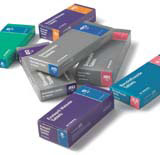Designers to gain from new pharmaceutical packaging law

Changes to the design of pharmaceuticals packaging, brought by legislation and lobbying, could lead to a surge of work for designers in the prescriptions medicine sector.
From the end of this month, it will become mandatory for any newly-approved medical product to have the name, strength and pharmaceutical form printed in Braille on its packaging. This is the first of a number of design improvements to medical packaging that are currently being sought.
The Royal Pharmaceutical Society and the National Pharmacy Association are both leaning on the Department of Health to introduce original pack dispensing at UK chemists. This would stipulate that all medicine is dispensed to the consumer in the original packs designed by the manufacturer, along with an accompanying Patient Information Leaflet, rather than broken from a bulk supply and repackaged by the pharmacist.
‘Pharmacists either dispense pre-packed products or have bulk containers and make up prescriptions on the spot,’ says Mark Chittenden, creative director at Creative Leap, which has developed pack designs for pharmaceuticals manufacturer Almus.
If original pack dispensing is introduced, in order to bring Britain into line with most European Union countries, the 45 per cent of medicines that are dispensed from broken bulk or split packs would require their own packaging designs, offering a run of work for designers.
This month, the National Patient Safety Agency unveiled Information Design for Patient Safety, the results of a year-long study into the design of patient information on medical packaging, conducted with the Helen Hamlyn Research Centre at the Royal College of Art. Written by HHRC research associate Thea Swayne, the report offers a comprehensive set of guidelines for pack designs. It will be distributed by NPSA head of design and human factors Colum Lowe to key stakeholders in the industry, from pharmaceuticals manufacturers to pharmacists and designers.
Problems for patients, uncovered by the study, include poor legibility on tablet blister packs, where small, light type is often unreadable under the glare of pharmacy lights or brand information is ‘degraded’ as the blister pockets are opened. Colour-coding can also cause confusion, due to either colour blindness or a reliance on colour codes over and above written information.
‘We have followed the journey of the pack from manufacture, through to hospitals, pharmacies, patients and eventually into the homes of users,’ explains Swayne. She examined the problems and requirements of each user group, with the aim of improving patient safety and minimising accidents.
The executive body of the Department of Health, the Medicines and Healthcare products Regulatory Agency, is undertaking a consultation on the implementation of EU legislation regarding on-pack information. The NPA claims that it is unacceptable for pharmacists to have to meet the Braille and PIL requirements themselves when repackaging from bulk supplies. It is calling for the introduction of original pack dispensing to overcome this problem.
See feature on inclusive design, page 14
background
• It is estimated that a third of medication errors result from confusion triggered by packaging and labelling
• General practitioners issue more than 660 million prescriptions per year
• Around 900 000 adverse incidents are thought to occur in the NHS each year, accounting for 10 per cent of hospital admissions and costing approximately £2bn
Source: Information Design for Patient Safety
-
Post a comment




